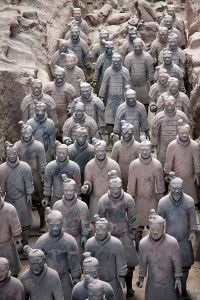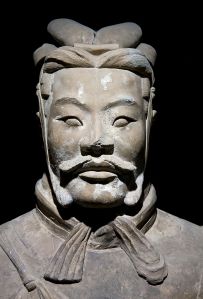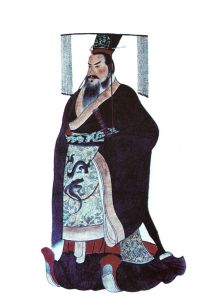 Today I am celebrating the discovery of the Terracotta Warriors in Xi’an, China in 1974. Some farmers were digging a well not far from the site where Emperor Qin Shi Huang, the first emperor of China, was laid to rest in 210 BC. Bits of terracotta had been turning up there for centuries. At first they thought they had found a kiln, but when they unearthed an entire life-sized figure, they knew they had something more important. They notified the authorities and government archaeologists were sent to begin excavations. Work at the site still continues and so far around 8,000 figures have been unearthed.
Today I am celebrating the discovery of the Terracotta Warriors in Xi’an, China in 1974. Some farmers were digging a well not far from the site where Emperor Qin Shi Huang, the first emperor of China, was laid to rest in 210 BC. Bits of terracotta had been turning up there for centuries. At first they thought they had found a kiln, but when they unearthed an entire life-sized figure, they knew they had something more important. They notified the authorities and government archaeologists were sent to begin excavations. Work at the site still continues and so far around 8,000 figures have been unearthed.
The first pit to be excavated was found to contain 6,000 warriors. The detail on the figures is incredible, from the rivets in their armour to the tread on the soles of their shoes. They vary in height according to rank. Although the heads of the warriors seem to have been made from eight  basic moulds, features have been added to make each one unique. Originally, the figures were painted in bright colours, but any remaining paint tends to flake of within minutes of its being exposed to the dry air. The soldiers also once carried real weapons including spears, swords and crossbows. Some rusted away long ago, some were looted shortly after they were buried, but some have been recovered. Swords have been found that were rust free and still sharp after more than two thousand years. They were found the be coated with chromium dioxide which has protected the blades. No one knows if the ancient Chinese knew how to do this on purpose or if it is just a happy accident.
basic moulds, features have been added to make each one unique. Originally, the figures were painted in bright colours, but any remaining paint tends to flake of within minutes of its being exposed to the dry air. The soldiers also once carried real weapons including spears, swords and crossbows. Some rusted away long ago, some were looted shortly after they were buried, but some have been recovered. Swords have been found that were rust free and still sharp after more than two thousand years. They were found the be coated with chromium dioxide which has protected the blades. No one knows if the ancient Chinese knew how to do this on purpose or if it is just a happy accident.
The warriors were placed there to guard the burial chamber of the Emperor. I have no idea whether it was a normal thing, in ancient China, to have yourself buried with thousands of clay warriors, but I’m going to put Emperor Qin Shi Huang in my category of brilliant eccentrics. He came to the throne at the age of only thirteen and managed to unite a collection of warring states into a single nation. He introduced a single currency and a single written language and also built a good network of roads and canals. All these are fine things for a powerful ruler to do. But there are a few other things I want to mention.
 During his reign he survived several assassination attempts including being attacked with a lute packed with lead and having a strongman throw a massive metal cone at him. In later life he became afraid of death and he had tunnels and passageways built between his palaces because he believed that being underground would protect him from evil spirits, and probably from assassins too. In 211 BC a meteor fell in his realm that was said to prophecy his death He had the object found, burned and crushed. He also became obsessed with finding the Elixir of Life which would give him immortality. Needless to say that left him prey to all sorts of charlatans. He once met a thousand year old magician called Anqi Sheng who could sometimes make himself invisible. In 219 BC he sent an expedition led by a man called Xu Fu to find Anqi Sheng and get from him the secret of his longevity. Xu Fu and his fellow adventurers did not find the magician and, probably sensibly, did not return. Legend has it that they sailed to Japan and colonised the islands there. The Emperor’s alchemists made him tablets that were supposed to make him live for ever. They didn’t. It was probably the mercury in the tablets that killed him.
During his reign he survived several assassination attempts including being attacked with a lute packed with lead and having a strongman throw a massive metal cone at him. In later life he became afraid of death and he had tunnels and passageways built between his palaces because he believed that being underground would protect him from evil spirits, and probably from assassins too. In 211 BC a meteor fell in his realm that was said to prophecy his death He had the object found, burned and crushed. He also became obsessed with finding the Elixir of Life which would give him immortality. Needless to say that left him prey to all sorts of charlatans. He once met a thousand year old magician called Anqi Sheng who could sometimes make himself invisible. In 219 BC he sent an expedition led by a man called Xu Fu to find Anqi Sheng and get from him the secret of his longevity. Xu Fu and his fellow adventurers did not find the magician and, probably sensibly, did not return. Legend has it that they sailed to Japan and colonised the islands there. The Emperor’s alchemists made him tablets that were supposed to make him live for ever. They didn’t. It was probably the mercury in the tablets that killed him.
The warriors were not the only figures that Qin Shi Huang had buried with him. Life-sized chariots and horses have also been found, along with acrobats and water birds. As I said, excavations are ongoing. In fact since I first wrote about the terracotta warriors a year ago, archaeologists believe they have located another 1,400 figures and possibly 89 war chariots. Then there is his burial chamber. It is estimated to be 690 meters long and 250 meters wide. It has never been excavated for two reasons. Firstly, no one is confident that they could safely preserve for posterity what might be inside. Secondly because no one knows how to protect the archaeologists from what might be inside.
There is a huge history of ancient China which was completed around 94 BC. It does not mention the buried army at all but it contains a description of the tomb. It tells us the 700,000 men were needed to build it. It is filled with rare artefacts and wonderful treasures. There are also crossbows primed and ready to fire at anyone who enters. But that is not the main concern. Inside his tomb there is a microcosm of his realm. The ceiling is set with jewels to represent the heavens It is lit by candles made from the fat of the man-fish. And no, before you ask, I don’t know what a man-fish is. There are also said to be a hundred rivers all set to flow mechanically and a vast sea. This is where the problem lies. They are all made from mercury. This could, of course, all be legendary nonsense, but soil tests in the area do reveal a very high mercury content.
What I like thinking about with the terracotta warriors is all the time they’ve been hidden underground. I think about all the hundreds of years of history I’ve covered, all the people I’ve read about who never knew anything about them, and I wonder how people ever managed to forget that they had once buried 6,000 life-size clay warriors. I like that they were discovered completely by accident by people who were just digging a well and it makes me wonder what other treasures might lie hidden. Sadly, the initial discoverers of the army seem to have profited little from their find. In fact, they have been turfed off their land to make way for a museum. So, it seemed the least I could do was to try to dig them out of the internet, dust them off and tell you their names. They were: Yang Zhifa, Yang Quanyi, Yang Peiyan, Yang Xinman, Yang Wenhai, Yang Yanxin and Wang Puzhi.